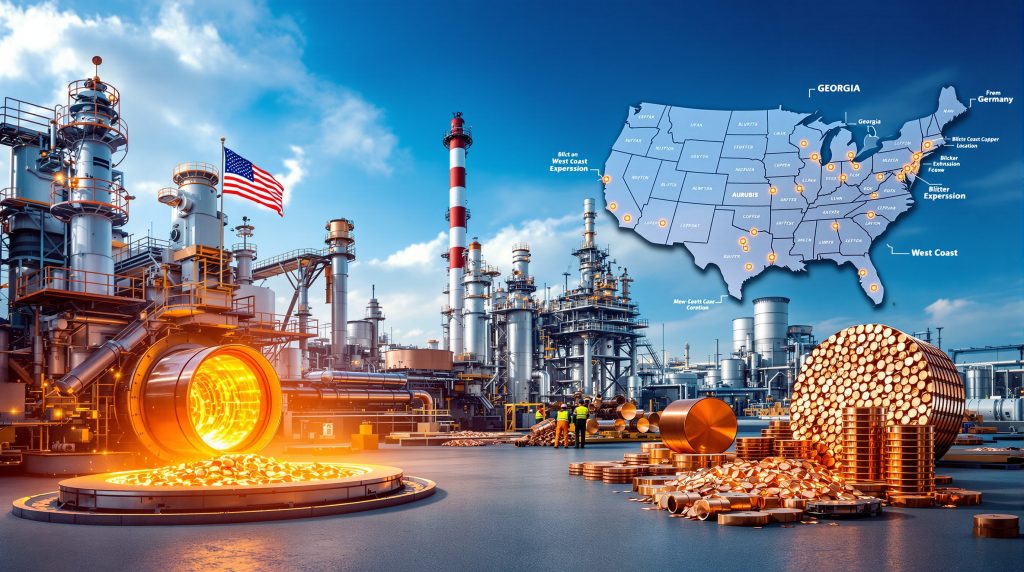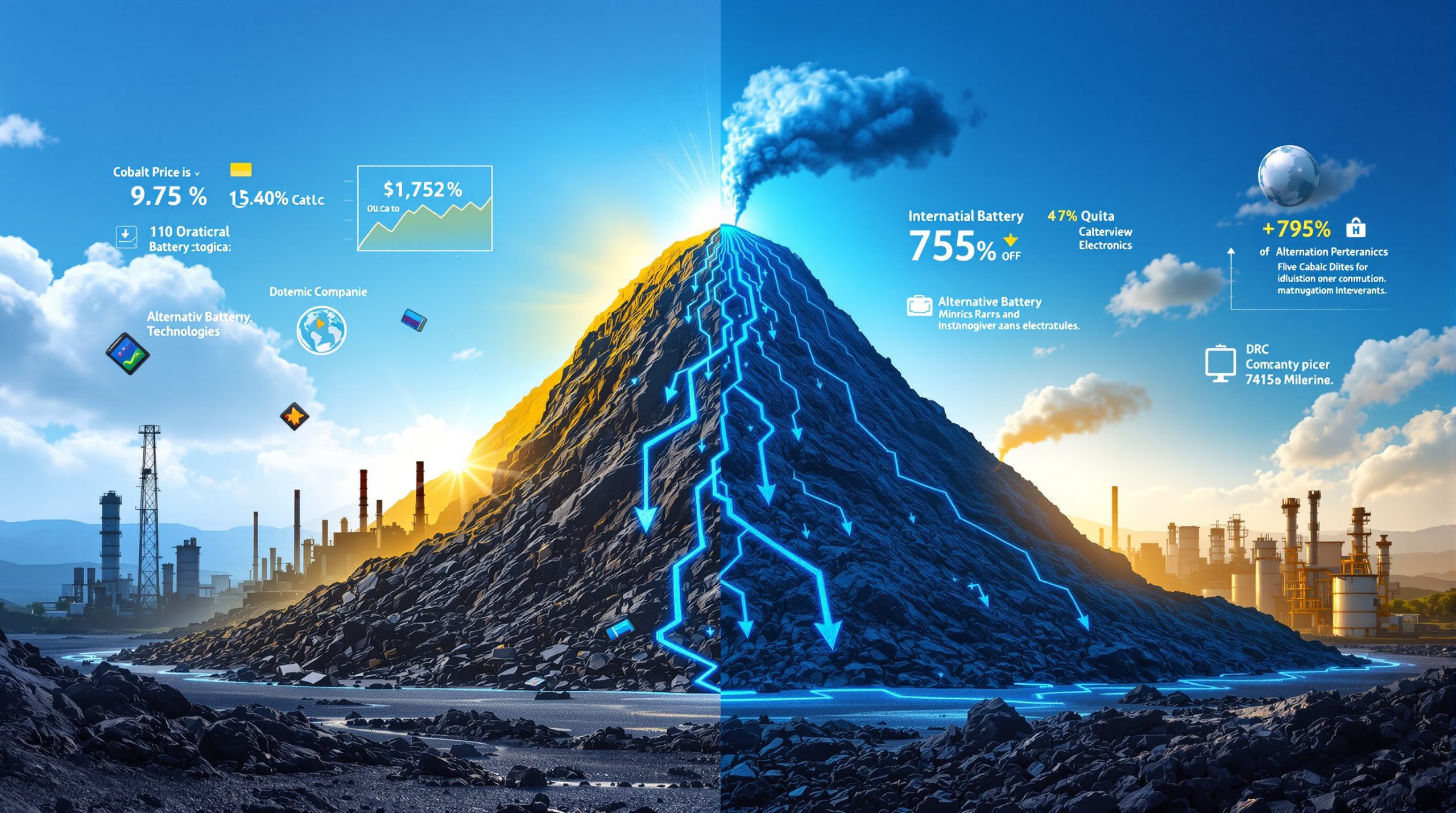How is Aurubis Expanding its US Copper Operations?
The Georgia Recycling Plant Milestone
Aurubis reached a historic milestone in late 2023 with the commencement of production at its Richmond, Georgia facility—the company's first greenfield plant constructed in 115 years. This state-of-the-art recycling facility represents a significant advancement in Aurubis' international expansion strategy, with an annual output capacity of 70,000 metric tons of high-grade blister copper.
The facility employs advanced recycling technology specifically designed to process complex materials, transforming various copper-containing scrap into valuable intermediate products. This development marks Aurubis' first major manufacturing presence in the United States, creating a strategic foothold in one of the world's largest copper markets.
Three Strategic Expansion Options Under Consideration
Following the successful launch of the Georgia plant, Aurubis is exploring three distinct expansion pathways to strengthen its position in the North American copper market. Each option presents different timelines, investment requirements, and strategic benefits.
Option 1: New Copper Smelter Construction
The most ambitious expansion scenario involves building an entirely new copper smelter in the United States. This option would significantly enhance domestic smelting capacity but requires substantial government support to be economically viable. According to Aurubis CEO Toralf Haag, preliminary discussions with U.S. government officials have yielded "positive signs" regarding potential assistance, though concrete proposals are still in development.
A new smelter would represent a long-term strategic investment with considerable benefits for US copper production outlook. However, the capital intensity, regulatory complexity, and extended timeline make this the most challenging of the three options.
Option 2: Georgia Facility Expansion
The second option involves expanding the existing Georgia recycling operation by adding an anode furnace and tank house. This upgrade would enable the facility to produce finished copper cathodes rather than stopping at the intermediate blister copper stage. The expansion could potentially include rod production capabilities to directly serve wire and cable manufacturers.
This approach offers several advantages:
- Leverages existing infrastructure and operational expertise
- Reduces implementation timeline to approximately 3-4 years
- Creates an integrated recycling-to-finished product facility
- Requires less capital than a completely new smelter
- Could proceed without extensive government assistance
Option 3: West Coast Recycling Plant
The third strategic option involves developing a second recycling plant on the U.S. west coast. This facility would complement the Georgia operation while capitalizing on increased scrap availability following recent tariff implementations that have limited exports.
Key benefits of this approach include:
- Geographic balance in Aurubis' U.S. operations
- Proximity to western states' scrap material sources
- Potential operational synergies with the Georgia facility
- Feasible 3-4 year implementation timeline without government assistance
- Strategic positioning in a region with significant copper demand
Why is the US Government Interested in Supporting Copper Production?
Critical Supply-Demand Imbalance in US Copper Market
The United States faces a significant and growing copper supply gap that threatens industrial resilience and strategic security. Current U.S. refined copper demand stands at approximately 1.7 million metric tons annually, with domestic production covering only about 50% of this requirement. This dependency on imports already creates vulnerability, but the situation is projected to worsen substantially.
By 2035, U.S. copper demand is expected to surge to 2.3 million metric tons—representing a 35% increase from current levels. Without additional domestic processing capacity, this widening supply gap will further expose critical industries to international supply disruptions and price volatility.
The limited number of operating copper smelters in the United States compared to global competitors highlights this vulnerability. While China operates approximately 60 copper smelters and Europe maintains 15, the U.S. has only three facilities including Aurubis' new Georgia plant.
Strategic Metal Independence Initiatives
Recent policy actions demonstrate increasing recognition of copper's strategic importance. Tariffs implemented on copper products (exempting raw materials like ores, concentrates, and cathodes) represent an effort to incentivize domestic processing while ensuring adequate raw material supply.
This tariff structure specifically encourages:
- Domestic processing of imported raw materials
- Retention of U.S.-generated scrap within domestic markets
- Investment in new processing capacity
- Development of the domestic copper value chain
These policies align with broader U.S. industrial strategy to reduce dependencies on foreign processing for critical minerals. Copper plays an essential role in numerous strategic sectors:
- Energy transition infrastructure (solar, wind, transmission)
- Electric vehicle production and charging networks
- AI-driven mining tech and data center infrastructure
- Defense manufacturing and advanced weapons systems
- Telecommunications and connectivity
Government discussions with Aurubis regarding potential support mechanisms for a new smelter reflect this growing policy emphasis on securing domestic supply chains for materials deemed essential to economic and national security.
Recycling Market Growth Potential
The U.S. copper recycling market presents substantial growth opportunities, with projections indicating a 26% expansion over the next decade. This growth would increase annual recycling volumes to approximately 555,000 metric tons—representing a significant portion of domestic copper demand.
Recent tariff policies limiting exports have increased domestic scrap availability, creating favorable conditions for recycling operations like Aurubis' Georgia facility. This policy-driven market shift supports the business case for additional recycling capacity.
Beyond economic benefits, expanded recycling operations offer several strategic advantages:
- Reduced reliance on imported refined copper
- Lower environmental footprint compared to primary production
- Conservation of natural resources through circular economy principles
- Enhanced resource security through domestic material recirculation
- Increased domestic value addition and manufacturing support
What Market Conditions Are Driving Aurubis' Expansion Strategy?
Record Copper Premiums and Price Trends
Market conditions have created a favorable environment for copper processing investments. Aurubis recently set its European customer premium at a record $315 per metric ton for 2024—a significant 38% increase from the previous year. These premiums reflect the additional charges above benchmark copper prices that customers pay for physical delivery, and their rise signals strong physical market demand amid tight supply.
Benchmark copper prices on the London Metal Exchange (LME) recently reached a 16-month peak of $11,000 per ton, driven by supply concerns stemming from mine disruptions in key producing regions including Indonesia, Chile, and the Democratic Republic of Congo. These higher price levels improve smelter economics and strengthen the business case for capacity expansion.
The combination of rising premiums and strong underlying copper price predictions creates a supportive environment for capital-intensive projects like smelter expansions or new facilities. While prices naturally fluctuate in commodity markets, the fundamental demand drivers for copper—including electrification, renewable energy, and digital infrastructure growth—suggest long-term support for prices.
Global Smelting Capacity Distribution Imbalance
The stark imbalance in global smelting capacity distribution creates both strategic vulnerability and market opportunity. As Aurubis CEO Toralf Haag highlighted, "There are 60 smelters in China, 15 in Europe, and now with us, only three in the U.S. So there's a big demand for smelting capacity."
This capacity disparity means:
- The U.S. must import significant volumes of refined copper
- Domestic concentrates may need export for processing
- Supply chain vulnerability during international disruptions
- Lost economic opportunity from value-added processing
- Strategic dependency on foreign nations for essential materials
For Aurubis, this capacity gap represents a significant market opportunity. Limited competition in the U.S. smelting sector, growing copper demand, and supportive government policy create favorable conditions for capacity expansion. The company's existing operational expertise in Europe provides a competitive advantage when evaluating U.S. expansion options.
Parallel European Investment Initiatives
While pursuing U.S. expansion opportunities, Aurubis is simultaneously investing in its European operations. The company plans a substantial 500 million euro investment in its Hamburg facilities, including a new precious metal refinery and complex recycling plant. These investments aim to boost production of high-value metals including platinum and antimony.
This parallel investment strategy demonstrates:
- Aurubis' commitment to multi-metal recovery beyond copper
- The company's financial capacity to pursue multiple growth initiatives
- Strategic focus on both established European and developing U.S. markets
- Technological leadership in complex material processing
- Long-term vision for growth across diverse geographic markets
The Hamburg investments will enhance Aurubis' ability to extract maximum value from complex feed materials, potentially providing technological insights that could benefit future U.S. operations. This dual-continent approach positions the company to capitalize on growth opportunities while maintaining its core European production base.
What Are the Economic and Environmental Benefits of the Expansion?
Job Creation and Economic Impact
Expansion of copper processing capacity in the United States would generate significant economic benefits, particularly through high-skilled industrial employment opportunities. Modern metallurgical facilities create diverse positions ranging from production operators and maintenance technicians to laboratory specialists, engineers, and management roles.
Beyond direct employment, copper facilities generate substantial indirect economic benefits:
- Supply chain development for local businesses providing materials and services
- Transportation and logistics employment for material movement
- Professional service opportunities (environmental, legal, accounting)
- Construction jobs during development phases
- Increased local spending from employee wages
The facility would also generate tax revenue for local communities and state governments while potentially attracting related businesses to create industrial clusters around copper processing. These clusters can amplify economic benefits through knowledge sharing, workforce development, and supply chain efficiencies.
Sustainability Advantages of Recycling-Focused Approach
Aurubis' emphasis on recycling offers significant environmental advantages compared to traditional primary smelting operations. Recycled copper requires up to 85% less energy to process than copper produced from ore, translating to substantially lower carbon emissions per ton of output.
Additional environmental benefits include:
- Conservation of natural resources through circular economy principles
- Reduced land disturbance compared to mining operations
- Lower water consumption than primary production
- Decreased waste material sent to landfills
- Reduced overall environmental footprint across the copper lifecycle
Modern recycling facilities like Aurubis' Georgia plant incorporate advanced emissions control technology to minimize environmental impact. These technologies include sophisticated air filtration systems, closed-water circuits for minimizing consumption, and waste heat recovery systems for energy efficiency.
Multi-Metal Recovery Capabilities
A key advantage of Aurubis' approach is sophisticated multi-metal recovery capabilities that maximize resource utilization from complex scrap materials. Advanced processing technology enables extraction of numerous valuable metals beyond copper:
Precious Metals:
- Gold from electronic components and connectors
- Silver from electrical contacts and industrial applications
- Platinum and palladium from automotive catalysts and electronics
Industrial Metals:
- Tin recovered from solder and bronze alloys
- Nickel extracted from various copper-nickel alloys
- Antimony captured from flame retardants and lead alloys
This multi-metal recovery strategy creates diversified revenue streams beyond copper production, improving facility economics and resource efficiency. It also reduces waste output by extracting maximum value from input materials through sophisticated metallurgical processes.
The planned European investments in precious metal refining and complex recycling demonstrate Aurubis' continued focus on technology advancement in this area, potentially creating innovations that could benefit future U.S. operations.
How Does This Project Fit Into Global Copper Market Dynamics?
Changing International Trade Patterns
Recent tariff implementations on copper products have begun reshaping international copper trade flows, with potentially significant long-term implications. By exempting raw materials (ores, concentrates, and cathodes) while targeting semi-finished and finished products, these policies create specific incentives that benefit domestic processors.
The policy impact includes:
- Redirecting scrap material that previously would have been exported to domestic processing
- Increasing domestic value addition through processing activities
- Potentially expanding finished product exports from U.S. facilities
- Modifying global supply chains to accommodate new trade realities
- Creating competitive responses from established copper-producing nations
For Aurubis specifically, these changing trade patterns support the business case for U.S. expansion. Increased domestic scrap availability provides feedstock for recycling operations, while tariff protection on finished products helps secure market position for potential future cathode production.
Technology and Innovation Factors
Technological innovation plays a crucial role in modern copper processing competitiveness. Advanced metallurgical processes, automation systems, and digitalization enable significant improvements in recovery rates, energy efficiency, and environmental performance.
Key technology factors influencing the sector include:
- Implementation of advanced process control systems for optimization
- Enhanced recovery rates for companion metals through refined separation techniques
- Improved environmental performance through emissions reduction technology
- Digital twins and predictive maintenance to maximize operational reliability
- Energy efficiency improvements to reduce carbon footprint
Aurubis' operational expertise from European facilities provides technological advantages when establishing or expanding U.S. operations. The company's experience with complex recycling materials and multi-metal recovery creates competitive differentiation in processing efficiency and value extraction.
Long-Term Strategic Positioning
Aurubis' U.S. expansion strategy represents positioning ahead of projected long-term copper demand growth. The anticipated 35% increase in U.S. copper consumption by 2035 will be driven by several converging trends:
- Accelerating electrification across transportation sectors
- Renewable energy infrastructure expansion
- Power grid modernization and capacity expansion
- Data center proliferation for AI and cloud computing
- Advanced manufacturing requiring high-conductivity materials
By establishing processing capacity ahead of this demand growth, Aurubis aims to secure market leadership in the expanding U.S. recycling sector. This forward-looking approach aligns with critical mineral security objectives while creating a resilient, diversified operational footprint across multiple continents.
The company's three-option approach (new smelter, Georgia expansion, or west coast recycling plant) provides strategic flexibility, allowing adaptation to evolving market conditions, regulatory environments, and US mining permits and support mechanisms.
FAQ: Aurubis US Copper Expansion
What is driving the increased demand for copper in the US?
The projected 35% increase in U.S. copper demand by 2035 stems from several converging factors. Electrification initiatives across transportation, industry, and residential sectors require substantial copper inputs, with electric vehicles using 3-4 times more copper than traditional vehicles. Renewable energy infrastructure—including solar arrays, wind turbines, and energy storage systems—is highly copper-intensive.
Data center construction has accelerated dramatically with AI development, creating significant demand for copper in power distribution, cooling systems, and connectivity infrastructure. Defense applications also rely heavily on copper for electronics, communications systems, and advanced weapons platforms.
Copper's exceptional electrical conductivity, thermal properties, and corrosion resistance make it irreplaceable in these growing sectors, driving sustained demand growth beyond general economic expansion rates.
How significant is the US copper supply gap?
The current U.S. refined copper supply gap is substantial and growing. With domestic production covering only about 50% of the 1.7 million metric ton annual demand, the U.S. already imports approximately 850,000 metric tons of refined copper annually.
This gap is projected to widen significantly as demand grows to an expected 2.3 million tons by 2035. Without new domestic processing capacity, import dependency could exceed 60% of total consumption, creating strategic vulnerabilities for critical industries including defense manufacturing, renewable energy, and digital infrastructure.
The limited domestic smelting capacity (only three facilities compared to China's 60) creates a structural constraint on supply security that cannot be quickly addressed due to the long lead times required for new facility development.
What advantages does recycling copper offer over primary production?
Recycled copper offers multiple significant advantages over primary production from ore. The energy requirements for recycling are up to 85% lower than primary production, resulting in substantially reduced carbon emissions and operating costs. Recycled copper maintains identical quality and conductivity to primary copper, as the metal does not degrade through recycling processes.
From an environmental perspective, recycling conserves natural resources, requires less water, produces less waste, and avoids the land disturbance associated with mining operations. Economically, recycling operations typically have lower capital intensity than new mines and primary smelters, enabling faster development timeframes.
In the U.S. context, recycling also reduces import dependency by maximizing utilization of domestically available materials rather than relying on imported concentrates or cathodes.
How does government support factor into copper industry development?
Government support plays a critical role in copper industry development due to several factors unique to the sector. The capital-intensive nature of smelting facilities—often requiring investments of hundreds of millions or billions of dollars—creates significant financial barriers to entry. Long development timelines (5-7 years for new facilities) and uncertain commodity price cycles increase investment risk.
Government support mechanisms can include:
- Tax incentives and credits for capital investments
- Grants or low-interest loans for construction and equipment
- Expedited or streamlined permitting processes
- Infrastructure development to support operations
- Research and development partnerships for technology advancement
- Tariff protection to ensure market access during development phases
- Energy cost subsidies or agreements to ensure competitive operating costs
These mechanisms help offset the substantial capital requirements and lengthy development timelines associated with new metallurgical facilities, enabling copper investment strategies that might otherwise be economically challenging despite their strategic importance.
What environmental safeguards are implemented in modern copper recycling?
Modern copper recycling facilities incorporate multiple environmental protection systems to minimize impact. Advanced air emission control technologies include baghouses, scrubbers, and catalytic reduction systems that capture particulates and convert harmful compounds before release. Water management systems typically operate on closed-loop principles, minimizing consumption through continuous treatment and recycling.
Waste management protocols ensure proper handling of residual materials, with increasing emphasis on zero-waste approaches that find beneficial uses for all process outputs. Energy efficiency measures include waste heat recovery systems, variable frequency drives, and process optimization to minimize consumption.
Facilities typically operate under comprehensive environmental management systems with continuous monitoring, regular auditing, and transparent reporting. Many facilities pursue certification under standards like ISO 14001 to validate environmental performance and demonstrate commitment to continuous improvement.
Ready to Spot the Next Major Mineral Discovery?
Gain immediate alerts on significant ASX mineral discoveries using Discovery Alert's proprietary Discovery IQ model, turning complex mineral data into actionable insights. Understand why historic discoveries can generate substantial returns by visiting Discovery Alert's dedicated discoveries page and begin your 30-day free trial today to position yourself ahead of the market.




